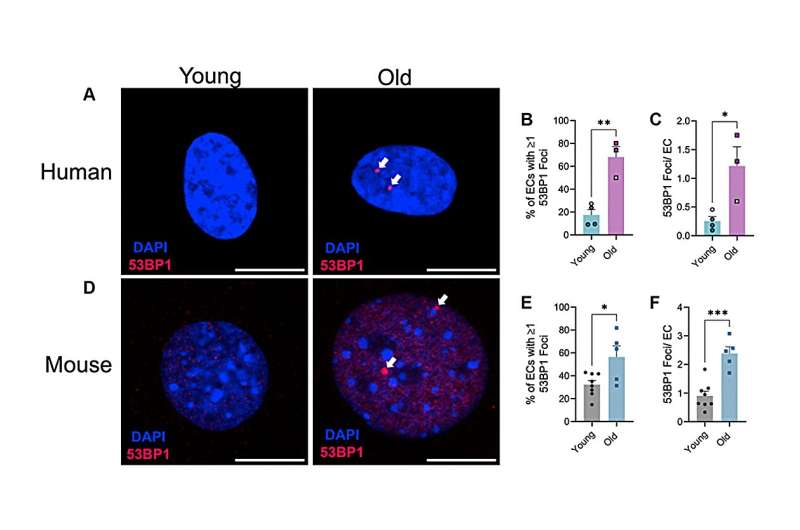This article has been reviewed according to Science X's editorial process and policies. Editors have highlighted the following attributes while ensuring the content's credibility:
fact-checked
proofread
Reducing double-strand DNA break repair exacerbates vascular aging, study finds

A new research paper was published in Aging, titled "Reduction of double-strand DNA break repair exacerbates vascular aging."
Advanced age is the greatest risk factor for cardiovascular disease (CVD), the leading cause of death. Arterial function is impaired in advanced age which contributes to the development of CVD. One underexplored hypothesis is that DNA damage within arteries leads to this dysfunction, yet evidence demonstrating the incidence and physiological consequences of DNA damage in arteries, and in particular, in the microvasculature, in advanced age is limited.
In their new study, researchers Samuel I. Bloom, Jordan R. Tucker, Daniel R. Machin, Hossein Abdeahad, AdeLola O. Adeyemo, Tyler G. Thomas, R. Colton Bramwell, Lisa A. Lesniewski, and Anthony J. Donato from The University of Utah, Florida State University and the Veterans Affairs Medical Center-Salt Lake City began by assessing the abundance of DNA damage in human and mouse lung microvascular endothelial cells and found that aging increases the percentage of cells with DNA damage.
"To explore the physiological consequences of increases in arterial DNA damage, we evaluated measures of endothelial function, microvascular and glycocalyx properties, and arterial stiffness in mice that were lacking or heterozygous for the double-strand DNA break repair protein ATM kinase," the researchers say.
Surprisingly, in young mice, vascular function remained unchanged which led the researchers to rationalize that perhaps aging is required to accumulate DNA damage. Indeed, in comparison to wild type littermate controls, mice heterozygous for ATM that were aged to ~18 mo (Old ATM +/−) displayed an accelerated vascular aging phenotype characterized by increases in arterial DNA damage, senescence signaling, and impairments in endothelium-dependent dilation due to elevated oxidative stress. Furthermore, old ATM +/− mice had reduced microvascular density and glycocalyx thickness as well as increased arterial stiffness.
"Collectively, these data demonstrate that DNA damage that accumulates in arteries in advanced age contributes to arterial dysfunction that is known to drive CVD," write the authors.
More information: Samuel I. Bloom et al, Reduction of double-strand DNA break repair exacerbates vascular aging, Aging (2023). DOI: 10.18632/aging.205066



















